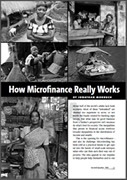How Microfinance Really Works
About half of the world’s adults lack bank accounts. Most of these “unbanked” are deemed too expensive to serve, or not worth the hassle created by banking regulations. But what may be good business from a banker’s perspective isn’t necessarily what’s best for society. The inequalities that persist in financial access reinforce broader inequalities in the distribution of income and wealth. This is the opening for microfinance and also its challenge. Microlending has been sold as a practical means to get capital into the hands of small-scale entrepreneurs who can then earn their way out of poverty. The idea appeals to our impulse to help people help themselves and to our conviction that bottom-up development depends on the embrace of the market. By eschewing governments and traditional charities, the sector promises to sidestep the bureaucracy and inertia that have hobbled other attempts to expand the opportunities of the poor.
